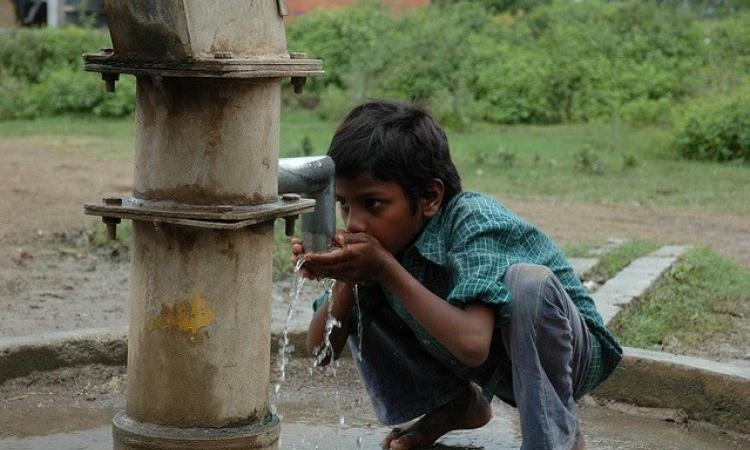
Up until two decades ago, the main sources of drinking water in Rajasthan included surface water from perennial ponds, reservoirs, lakes, dams, rivers and streams with borewells and tubewells used sparingly and only in remote areas. All this changed when guinea worm infections started appearing in the state.
Guinea worm disease (GWD), is a debilitating infection caused by the parasite Dracunculus medinensis that lodges itself in a person’s body causing fever, body pain and swelling and blisters on the legs and feet.
People become infected with guinea worm by drinking water from ponds and stagnant water sources. These water sources contain tiny “water fleas” that carry guinea worm larvae that lead to the infection. There is no drug to treat the disease and no vaccine to prevent the infection. Certain measures are recommended to be taken to prevent the spread of the disease that include:
- drinking water from protected sources
- filtering water from unsafe sources using a cloth filter or a pipe filter
- treating unsafe drinking water sources with an approved larvicide
- providing communities with new safe sources of drinking water
- repairing broken safe water sources like hand pumps
One crisis to another
The paper ‘Fluoride distribution in drinking groundwater in Rajasthan, India’ published in the journal Current Science describes how a large number of borewells and tubewells with hand pumps were dug in remote areas of Rajasthan as a part of the guinea worm eradication programme since 1986. In the process, all traditional drinking water sources, such as stepwells and open wells were closed to stop the reproductive cycle of the guinea worm. Following this, the state was declared guinea worm disease free in 1997.
However, this excessive dependence on borewells and tubewells in the state as sources of water has now led to the spread of another more serious health problem in the region, hydrofluorosis, that was earlier restricted to a few areas.
Of the 13,334 habitations affected by fluoride in the country, Rajasthan has the highest number at 6,589. As many as 40 lakh people in the state are affected by fluorosis. Studies reveal that water in almost all borewells and tubewells fitted with a hand pump located in rural areas of Rajasthan is contaminated with fluoride and most of them have fluoride above the maximum acceptable limits, which is not safe for both human and animal health. Districts shown in blue and red in the graph below have fluoride levels in the range of 10.1-20 ppm and >20ppm respectively and are highly prone to chronic fluoride poisoning.
What makes the region vulnerable to high fluoride in water?
The geology of the region and the extraction of groundwater from deeper sources through borewells and tubewells have triggered water quality problems in Rajasthan. Digging deeper has exposed the fluoride-bearing minerals in host rocks and sediments in the region. The decomposition, dissociation, dissolution and interaction of these rocks with water help fluoride to dissolve in the water increasing its content in the groundwater of the region.
Besides this, climate and physiography also have an impact. Areas with less rainfall have been found to have waters with higher fluoride content as compared to groundwater in high rainfall areas despite similar hydrogeological formation. Thus groundwater in districts like Chittorgarh, Udaipur and Banswara that receive higher rainfall have low fluoride content compared to Ajmer and Bhilwara districts.
Hilly areas have water with low fluoride content as compared to plain areas. Dilution along with rapid flushing out of salts in high rainfall and hilly areas result in low fluoride content in water. In the arid plains of Rajasthan, there is little chance of fluoride being washed away during periods of scanty rainfall as compared to other states. The weathering and leaching process, mainly by moving and percolating water, also plays an important role in reducing or increasing fluoride concentrations in groundwater. Other factors like chemical composition, presence and accessibility of fluoride minerals and contact time between the source of minerals and water also govern the release of fluoride into the water.
What can be the way out?
The paper informs that although de-fluoridation using the Nalgonda technique has been tried in the area, its success rate at the community level has been found to be poor due to lack of community participation and responsibility, proper monitoring and maintenance.
Although well-meaning, quick fixes to health problems maybe beneficial in the short term, we need long-term, sustainable solutions at the policy level to avoid further damages and to deal with the problem in hand more effectively. Here are some sustainable ways to fix similar water quality problems:
- Developing an understanding of the hydrogeology of the region, the aquifers, hidden sources of groundwater and the impact of the excessive withdrawal of water on the quality and the quantity of the groundwater resources in the region.
- Generating data by conducting surveys on fluoride distribution in water sources to get an idea of the extent of the problem.
- Adoption of long-term sustainable methods such as harvesting and conserving rainwater to obtain fluoride-free drinking water.
- Turning back to traditional water sources and supplying treated water obtained from perennial ponds, wells, reservoirs, lakes, dams, rivers and streams to the villages.
- Most important in all these efforts is the involvement of the community in undertaking initiatives that focus on providing sustainable solutions to the fluorosis problem such as rainwater harvesting and community-level treatment of water sources.